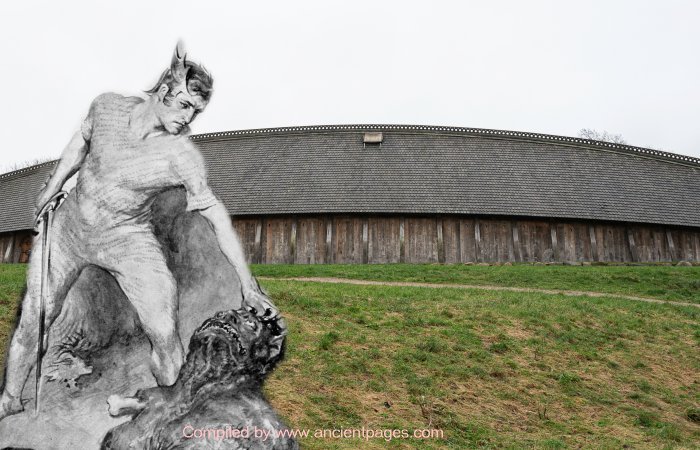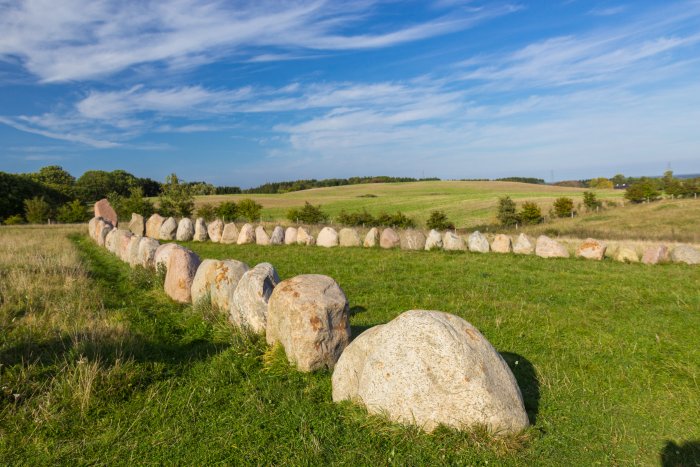
Ellen Lloyd – AncientPages.com – The mighty Viking Hall Lejre is not mentioned in the epic Beowulf, but there might be a connection between the hero and the impressive Viking Age building. Is it possible Beowulf visited the Lejre Viking Hall in Denmark?
From the epic, we learn that Beowulf traveled to the land of the Danes, where he visited King Hrothgar and Queen Wealtheow in the Hall of Heorot.
Lejre Viking Hall. Credit: Adobe Stock – Stig Alenas
In the Old English, Heorot is the name for a stag. The Anglo-Saxon epic Beowulf provides insights into the significance of Heorot, which served as the seat of rule for King Hrothgar. The narrative unfolds with the monster Grendel launching a brutal attack and slaughtering the hall’s inhabitants. In response, the Geatish hero Beowulf defends the royal hall and ultimately defeats Grendel. However, the conflict escalates when Grendel’s mother seeks vengeance, attacking the hall’s inhabitants. Once again, Beowulf emerges victorious, defeating Grendel’s mother, thus safeguarding the sanctity of Heorot and the authority it represents.
Where was the Hall of Heorot located? Could Beowulf have visited Lejre, Denmark’s largest Viking hall?
We cannot answer this question due to the lack of evidence; all we have are speculations. After all, unsurprisingly, the author of Beowulf focused on creating an adventurous tale, not a historical one. However, the importance of Lejre should not be underestimated.
The Viking Hall is mentioned in numerous Sagas, legends, and myths. Lejre is associated with the mythical Royal family of the Scyldings, a Dynasty of Danish kings who conquered and ruled Denmark, Sweden, and regions of England, Ireland, and North Germany.
In the Beowulf story, Scyld Scefing is mentioned as the legendary founder of the King of the Danes. Hrothfar, the friend of Beowulf and King of Sjaelland (Zealand), belonged to the royal home, which great—grandfather Scyld Scefing funded. So, we have reason to assume there is some unmentioned connection between Beowulf and the Lejre Viking Hall.
As explained by Karl P. Wentersdorf, “the Anglo-Saxon poet’s vision of Hrothgar’s headquarters was based on familiarity with the traditional Germanic royal halls. These were invariably built of massive timbers, a structural feature that is underscored by the frequent references in historical and literary sources to their destruction by fire. In the course of the twentieth century, the written testimony was strikingly sustained by archaeological excavations in both Scandinavia and England.
Whereas Beowulf himself was Geatish and came from what is now southern Sweden, the king he set forth to rescue was the ruler of the Scyldings, a Danish people living on the island of Zealand. The stronghold of the Scylding dynasty was located at a place called Lejre, near modern Roskilde, at the very southern end of the Roskilde Fjord, and the settlement was inhabited uninterruptedly from the latter part of the seventh century to the conclusion of the tenth.
Beowulf’s encounter with the dragon. Credit: Marshall Logan – Public Domain
The largest structure in the compound , of which only the foundations have survived, was a rectangular building 45.5 meters in length; its width ranged from 8 meters at the gable ends to 11.5 meters at the center. Evidence of occupation showed that this was where the Scylding kings feasted their thanes and entertained visitors. About 50 meters away was a second long-hall, 36 by 7 meters; it was used for storage and stabling purposes. “
According to the Sagas, the Scyldings include legendary figures such as Ragnar Lodbrok, Skjöldr Hrólf Krakim, and Harald Hiltertooth.
Lejre Viking Hall cannot be dismissed as mere mythology due to the conclusive archaeological evidence that confirms its significant role during the Iron Age and the Viking Age. The archaeological findings substantiate that Lejre was an influential site of historical importance in those periods, preventing it from fading into obscurity as a forgotten legend.
There is no doubt that the spot where Lejre Viking Hall was raised had been chosen with great care. Archaeologists have examined two great halls in the area. The first Viking Hall Lejre was built close to the hill Fredshøjsgård and a Bronze Age mound- Not far away, there is also an even older megalith grave known as Harald Hildetand mound. Known under the English name Harald Wartooth or Harold Hiltertooth was a semi-legendary Danish king who is believed to have lived three generations before the conquest of parts of England by the sons of Ragnar Lodbrok in the 860s-870s.
Harald Wartooth at the Battle of Bråvalla. Illustration by the Danish Lorenz Frølich in a 19th-century book. Credit: Public Domain
Historical accounts suggest that Hildetand succeeded his father as the King of Zealand and expanded his realm to include Jutland, parts of Sweden, and the historical northern German province of Wendland. Various sources recount that Hildetand was ultimately defeated and killed in the legendary Battle of Bråvalla, though the details surrounding this event remain shrouded in myth and uncertainty.
The Lejre area is notable for the significant number of Bronze Age burials scattered throughout the region. This concentration of ancient burial sites suggests that this specific location played a significant role in the lives of our ancestors during that era. However, the exact reasons behind this area’s importance remain unclear and open to further investigation and interpretation.
Interestingly, historical research has shed light on the ancient mounds surrounding the Lejre Viking Hall. These mounds were strategically constructed to create the illusion that rulers in the hall had inherited their power through multiple generations. However, evidence suggests that the individuals buried in these mounds, dating back thousands of years, were unrelated to the Lejre Viking Hall rulers. This finding provides valuable insight into the symbolic and political significance of these ancient structures, which were likely used to reinforce the perceived legitimacy and lineage of the ruling class.
Viking Age stone ship at Lejre. Credit: Adobe Stock – Tomtsya
The Lejre site is also home to impressive ship burials, one of which is almost 80 meters in length. One burial stands out from the typical Viking graves. Upon excavation, archaeologists discovered the remains of a young man with multiple broken bones and deformed feet. Interestingly, despite his physical condition, he appears to have held a high social status, as evidenced by the presence of a sacrificed human buried alongside him.
This finding suggests that physical impairments did not necessarily preclude individuals from attaining prominent positions within Viking society.
As time passed, Lejre rulers realized they needed a new Viking Hall.
Then, something unusual happened that cannot be easily explained. A new, almost identical Viking Hall was built in a new place. However, the old hall was not burned down. Vikings had a tradition of either burning or burying their longhouses. According to Marianne Hem Eriksen, at the Department of Archaeology, Conservation, and History at the University of Oslo, burial mounds may mark the tomb of a house as that of a human. After a longhouse burned to the ground, one or more burial mounds were placed on top of its remains.
The Vikings had a unique perspective on the relationship between the human body and the house. This viewpoint suggested that the house borrowed numerous features from the human form. It is highly plausible that the Vikings believed the house possessed an essence or a soul, which could explain why they deemed it necessary to provide a proper burial for their dwellings. This belief system highlights the Vikings’ profound connection with their living spaces, attributing a spiritual significance to their homes.
The old Lejre Viking Hall was left untouched and abandoned, even though the new hall was slightly larger and had similar designated spaces for rituals and ceremonies. This raises intriguing questions that may never be fully answered, such as whether the legendary figure Beowulf ever visited the Lejre Viking Hall.
While we face these unanswered queries, it is worth noting that for those interested in ancient history and visiting Denmark, the enormous reconstructed Viking Hall at Lejre offers an opportunity to gain insights into this fascinating era. Exploring this site can provide a tangible connection to the Viking heritage and the mysteries surrounding their cultural practices.
Written by Ellen Lloyd – AncientPages.com
Copyright © AncientPages.com All rights reserved. This material may not be published, broadcast, rewritten or redistributed in whole or part without the express written permission of AncientPages.com
Expand for references
Wentersdorf, Karl P. “The ‘Beowulf’-Poet’s Vision of Heorot.” Studies in Philology 104, no. 4 (2007): 409–26.
Ellen Lloyd – Why Did Vikings Burn And Bury Their Longhouses? – AncientPages.com
Anna Lihammer – Vikingatidens härskare
Anders Hultgård – Midgård brinner. Ragnarök i religionshistorisk belysning









